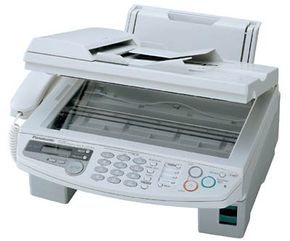Modern Fax Machines
A modern fax machine does not have the rotating drums and is a lot faster, but it uses the same basic mechanics to get the job done:
- At the sending end, there is some sort of sensor to read the paper. Usually, a modern fax machine also has a paper-feed mechanism so that it is easy to send multi-page faxes.
- There is some standard way to encode the white and black spots that the fax machine sees on the paper so that they can travel through a phone line.
- At the receiving end, there is a mechanism that marks the paper with black dots.
A typical fax machine that you find in an office is officially known as a CCITT (ITU-T) Group 3 Facsimile machine. The Group 3 designation tells you four things about the fax machine:
Advertisement

- It will be able to communicate with any other Group 3 machine.
- It has a horizontal resolution of 203 pixels per inch (8 pixels/mm).
- It has three different vertical resolutions: Standard: 98 lines per inch (3.85 lines/mm) Fine: 196 lines per inch (7.7 lines/mm) Super fine (not officially a Group 3 standard, but fairly common): 391 lines per inch (15.4 lines/mm)
- It can transmit at a maximum data rate of 14,400 bits per second (bps), and will usually fall back to 12,000 bps, 9,600 bps, 7,200 bps, 4,800 bps or 2,400 bps if there is a lot of noise on the line.
The fax machine typically has a CCD or photo-diode sensing array. It contains 1,728 sensors (203 pixels per inch), so it can scan an entire line of the document at one time. The paper is lit by a small fluorescent tube so that the sensor has a clear view.
The image sensor looks for black or white. Therefore, a single line of the document can be represented in 1,728 bits. In standard mode, there are 1,145 lines to the document. The total document size is:
1,728 pixels per line * 1,145 lines = approximately 2,000,000 bits of information
To reduce the number of bits that have to be transmitted, Group 3 fax machines use three different compression techniques:
- Modified Huffman (MH)
- Modified Read (MR)
- Modified Modified Read (MMR)
See Electronics Plus: Facsimile Theory for a discussion of these compression types. The basic idea in these schemes is to look for "runs" of same-color bits. For example, if a line on the page is all white, the modem can transmit a dozen or so bits rather than the full 1,728 bits scanned for the line. This sort of compression can cut transmission time by a factor of at least two, and for many documents much more. A document containing a significant amount of white space can transmit in just a few seconds.
On the next page, we'll talk about receiving faxes.
